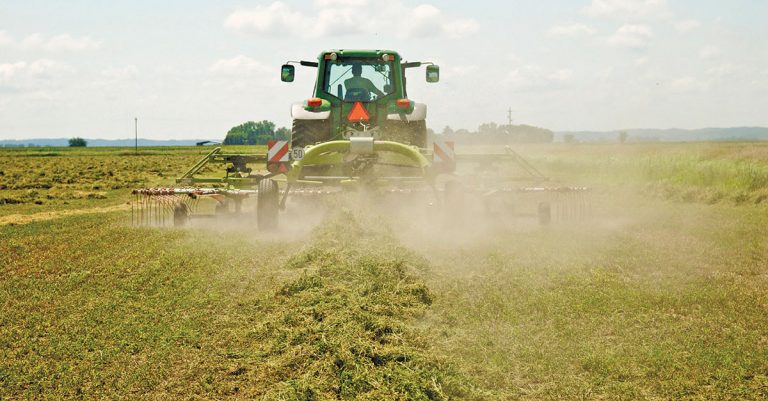
Photo: Getty Images
In order to understand the factors that influence lucerne hay quality and yield, it is necessary to have a basic understanding of the biology of the lucerne plant.
As the plant matures, the stems become more lignified in order to support the plant as it grows heavier during flowering. The stems, rather than the leaves, also begin to make up a greater proportion of the plant. This results in higher yield, but lower quality.
The lucerne also takes longer to dry due to the thicker stems, which in turn causes increased leaf loss due to shattering (lucerne leaves dry out three to five times faster than the stems). The main objective of lucerne hay production should therefore be to strive for the ideal balance between yield and quality.
Rain damage
The extent of reduction in yield and quality of lucerne hay depends on heat, irrigation, cutting schedule, harvest management and weather patterns. Of these, harvest management has by far the greatest impact on forage quality.
Moreover, it is under the direct control of the grower. Producing lucerne hay for maximum yield and quality requires an understanding of how environmental and management factors influence crop growth and development.
The smallest amount of untimely rain can postpone the harvesting process, causing rapidly maturing lucerne to decline in quality very rapidly. Rain just before cutting slows down drying after cutting, as the soil remains moist despite sunshine and low humidity. However, rain before harvesting is only one potential problem. Even larger difficulties can occur when it rains after cutting.
Firstly, rain increases the amount of time needed for lucerne to dry, as well as the number of times the lucerne is mechanically handled, which encourages further leaf loss. Rain on lucerne in the drying process can decrease the amount of leaves retained from 62% to 38%. Partially dried lucerne that is exposed to rain loses much of its nutrients due to leaching, as most are water-soluble.
Secondly, high humidity with no wind poses a problem, as it hinders evaporation from the windrow by leaving no room for replacement of saturated air with unsaturated air. The additional drying time caused by rain also leads to damage to lucerne regrowth due to shading from the windrow.
Heat damage
Lucerne grown in high heat produces a high protein content, which is a plus. However, when taking into account that this lucerne also has a high fibre content, it becomes irrelevant.
A high temperature, which increases the rate of plant maturation and cell wall lignification, has a dominant effect. Therefore, the rate of decline in digestibility with time is faster in summer, when temperatures are high, than in spring or autumn.
Another problem is high nocturnal temperatures, which cause respiration at night and thus a decline in valuable nutrients, and the plant is also unable to store root carbohydrates under short cutting schedules. The heat-driven growth rates not only deplete root reserves, but also increase fibre content, reduce soluble, highly digestible carbohydrates, and reduce quality.
A higher level of soluble carbohydrates and slower lignification are thought to be the
major reasons for the high quality of cool-season-grown lucerne hay, regardless of where it is grown.
During the day, the inability of the plant canopy to cool itself is a problem. The higher rainfall experienced in the current season in some parts of the country [this study examined the Douglas region in the Northern Cape], combined with high humidity, exacerbates the problem, as evaporative cooling does not work as well.
This, coupled with high respiration rates at night, as well as water and salt stress, is thought to cause early flowering, smaller leaf size, and lower growth rates. Thus, even the traditional 21-day cutting schedule does not help to ensure a high-quality product.
Ideal temperature
Premature flowering is identified not only by shorter plants, but by reduced stem numbers. This response may be due to water stress, or the combined effect of low root carbohydrates and high temperatures.
From the literature, it is evident that high temperature followed by a cold period decreases the growth rate of plants, the effect being more severe on lucerne, as indicated in Table 1.
| Table 1: Monthly average NLQI values between 2017 and 2021 | ||||
| Month | 2017/18 | 2018/19 | 2019/20 | 2020/21 |
| September | 104 | 107 | 104 | 101 |
| October | 104 | 107 | 104 | 104 |
| November | 103 | 105 | 102 | 100 |
| December | 102 | 104 | 101 | 100 |
| January | 102 | 103 | 102 | 101 |
| Avg NLQI | 103 | 105 | 103 | 101 |
| *NLQI = New Lucerne Quality Index | ||||
The current situation regarding lucerne hay production in South Africa can be seen and compared with previous years in Tables 1 and 2. In Table 1, a clear decrease in new lucerne quality index values (and thus lucerne quality) over the past three years is visible. Table 2 gives a detailed distribution of the percentage of lucerne in each grade category over lucerne hay production periods in the past four years.
| Table 2: Percentage of different grades of lucerne hay certified | ||||
| Month | 2017/18 | 2018/19 | 2019/20 | 2020/21 |
| September | ||||
| Prime | 63,64 | 76,9 | 61,44 | 43,47 |
| Grade 1 | 29,97 | 15,49 | 31,33 | 37,54 |
| Grade 2 | 3,7 | 4,89 | 5,44 | 13,83 |
| Grade 3 | 2,69 | 2,72 | 1,78 | 5,15 |
| October | ||||
| Prime | 63,4 | 82,78 | 57,36 | 60,27 |
| Grade 1 | 34,12 | 16,13 | 39,25 | 34,97 |
| Grade 2 | 2,23 | 0,089 | 2,63 | 2,75 |
| Grade 3 | 0,25 | 0,21 | 0,76 | 2 |
| November | ||||
| Prime | 60,14 | 71,44 | 39,73 | 23,36 |
| Grade 1 | 37,34 | 26,36 | 54 | 59,22 |
| Grade 2 | 2,33 | 2,14 | 4,99 | 13,47 |
| Grade 3 | 0,18 | 0,05 | 1,28 | 3,94 |
| December | ||||
| Prime | 43,14 | 58,74 | 32,71 | 19,37 |
| Grade 1 | 50,17 | 35,69 | 53,86 | 62,54 |
| Grade 2 | 5,24 | 4,91 | 7,34 | 14,52 |
| Grade 3 | 1,45 | 0,65 | 6,09 | 3,57 |
| January | ||||
| Prime | 40,51 | 52,45 | 16,45 | 11,06 |
| Grade 1 | 51,95 | 40,19 | 54,79 | 62,92 |
| Grade 2 | 6,48 | 6,13 | 16,03 | 17,66 |
| Grade 3 | 1,05 | 1,23 | 12,73 | 8,36 |
Cold injury, whether visible frost is present or not, may affect the growth of both established lucerne plants as well as newly emerged seedlings. This has a negative effect on both yield and quality.
The production of prime-quality lucerne normally takes place during September, October and November.
However, from the 2019/2020 production season until the current one, there was deviation from normal climatic patterns in some of the central production regions, while 2018/2019 presented a more ideal lucerne production climate with night-time temperatures below 20˚C; these conditions give the plants an opportunity to translocate reserves to their roots.
In contrast, high nocturnal temperatures promote respiration at night, which burns away valuable carbohydrates and increases the fibre content of the plant while also having a negative effect on regrowth. Extremely low night-time temperatures, however, can cause cold damage. The ideal temperatures for lucerne growth are between 22˚C and 24˚C.
Temperature fluctuations
In October of 2018, 2019 and 2020, a fair amount of prime lucerne was produced. However, the temperatures varied greatly from day to day, as did the gaps between maximum and minimum temperatures during October and November of 2019 and 2020, and these factors caused a decline in prime lucerne production from 2018/2019 to 2020/2021 (see Table 1).
Fluctuations in temperature cause instability in the physiological development of the lucerne plant. November 2020 saw much more rain in comparison with previous years in the Douglas area; this, combined with the temperature fluctuations, caused the significantly low levels of prime lucerne produced in the current production season (see Table 2).
As previously mentioned, evaporative cooling is not efficient when there is high rainfall and high humidity. During December 2020 and January 2021, respiration at night due to high nocturnal temperatures was a common occurrence, therefore lower-quality lucerne is naturally expected for the current season.
Data gap
Research on the influence of weather on lucerne in South Africa is in short supply. The data used in this is report was collected fairly recently and, thus far, it can merely help us understand a production season such as the one we are experiencing now, which is almost unique.
Email Walter van Niekerk at [email protected].











